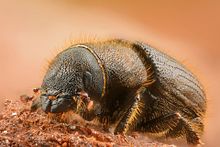kairomone
Jump to navigation
Jump to search
English[edit]
Etymology[edit]

Blend of Ancient Greek καιρός (kairós, “advantage; profit”, noun) + English pheromone,[1] coined in the 1970 article “Allomones and Kairomones: Transspecific Chemical Messengers” by the American geneticist William Lacy Brown, Jr. (1913–1991), the German-American ecologist and entomologist Thomas Eisner (1929–2011), and the American ecologist Robert Harding Whittaker (1920–1980) which was published in BioScience: see the quotation.
Pronunciation[edit]
- (Received Pronunciation) IPA(key): /ˈkaɪɹə(ʊ)məʊn/
Audio (Southern England) (file) - (General American) IPA(key): /ˈkaɪɹəˌmoʊn/
- Hyphenation: kai‧ro‧mone
Noun[edit]
kairomone (plural kairomones)
- (biochemistry, ecology) Any substance produced by an individual of one species (often an insect) that benefits the recipient which is of a different species but is harmful to the producer. [from 1970]
- [1970 January, William L[acy] Brown, Jr., Thomas Eisner, Robert H[arding] Whittaker, “Allomones and Kairomones: Transspecific Chemical Messengers”, in BioScience, volume 20, number 1, Washington, D.C.: American Institute of Biological Sciences, , →ISSN, page 21:
- Among these substances, we propose to designate two major functional groupings by the terms allomone and kairomone, chosen as intentional parallels to the term pheromone.]
- 1973 December, L. B. Hendry, P. D. Greany, R. J. Gill, “Kairomone Mediated Host‐finding Behavior in the Parasitic Wasp Orgilus lepidus”, in Entomologia Experimentalis et Applicata, volume 16, number 4, Amsterdam: Nederlandse Entomologische Vereniging [Netherlands Entomological Society], , →ISSN, →OCLC, abstract, page 471:
- Host‐finding by the parasitic wasp Orgilus lepidus, a braconid parasite, is mediated by two kairomones present in the frass of the host insect, the potato tuberworm.
- 2000 August, D. J. Brothers, G[unther] Tschuch, F. Burger, “Associations of Mutillid Wasps (Hymenoptera, Mutillidae) with Eusocial Insects”, in Insectes Sociaux, volume 47, Heidelberg: Birkhäuser Verlag for the International Union for the Study of Social Insects, , →ISSN, →OCLC, pages 201–211:
- Mutillids apparently use odour signals (kairomones) while actively running in suitable locations for finding such hosts, and must spend much time searching, with little prospect of finding numerous hosts.
Hypernyms[edit]
Coordinate terms[edit]
Derived terms[edit]
Translations[edit]
any substance produced by an individual of one species that benefits the recipient which is of a different species but is harmful to the producer
References[edit]
- ^ Compare “kairomone, n.”, in OED Online
 , Oxford, Oxfordshire: Oxford University Press, June 2020; “kairomone, n.”, in Lexico, Dictionary.com; Oxford University Press, 2019–2022.
, Oxford, Oxfordshire: Oxford University Press, June 2020; “kairomone, n.”, in Lexico, Dictionary.com; Oxford University Press, 2019–2022.
Further reading[edit]
Categories:
- English terms borrowed from Ancient Greek
- English learned borrowings from Ancient Greek
- English terms derived from Ancient Greek
- English 3-syllable words
- English terms with IPA pronunciation
- English terms with audio links
- English lemmas
- English nouns
- English countable nouns
- en:Biochemistry
- en:Ecology
- English terms with quotations
- English blends
- English coinages